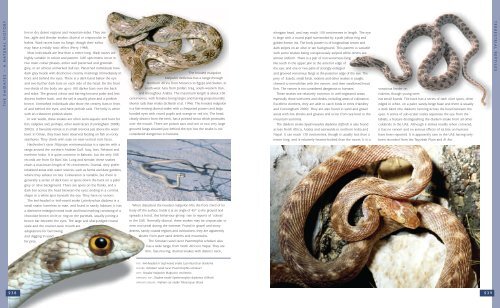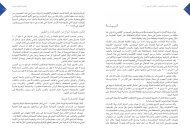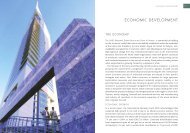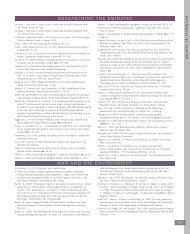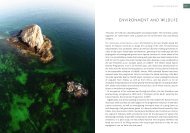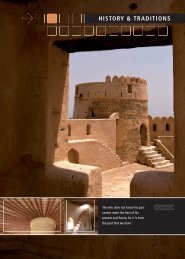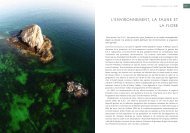TERRESTRIAL REPTILES - UAE Interact
TERRESTRIAL REPTILES - UAE Interact
TERRESTRIAL REPTILES - UAE Interact
You also want an ePaper? Increase the reach of your titles
YUMPU automatically turns print PDFs into web optimized ePapers that Google loves.
T H E E M I R A T E S – A N A T U R A L H I S T O R Y<br />
live in dry desert regions and mountain-sides. They are<br />
fast, agile and slender snakes, diurnal or crepuscular in<br />
habits. Wadi racers have no fangs, though their saliva<br />
may have a mildly toxic effect (Perry 1988).<br />
Most individuals are less than a metre long. Wadi racers are<br />
highly variable in colour and pattern. <strong>UAE</strong> specimens occur in<br />
two main colour phases; either well patterned and greenishgrey,<br />
or an almost unmarked dull tan. Patterned individuals have<br />
dark grey heads with distinctive creamy markings immediately in<br />
front and behind the eyes. There is a dark band below the eye<br />
and two further dark bars on each side of the head. On the front<br />
two-thirds of the body are up to 100 darker bars over the back<br />
and sides. The ground colour and barring become paler and less<br />
distinct further back, and the tail is usually plain and a pinkish<br />
brown. Unmarked individuals also show the creamy bars in front<br />
of and behind the eyes, and have pinkish tails. The belly is white<br />
with an iridescent pinkish sheen.<br />
In wet wadis, these snakes are often semi-aquatic and hunt for<br />
fish, tadpoles and, perhaps, other wadi racers (Cunningham 2000b;<br />
2002c). A favourite retreat is in small crevices just above the water<br />
level. In Oman, they have been observed feeding on fish on rocky<br />
seashores. They climb with ease on near-vertical rock faces.<br />
Hardwicke’s racer Platyceps ventromaculatus is a species with a<br />
The hooded malpolon<br />
Malpolon moilensis has a range through<br />
Northern Africa from Morocco to Egypt and Sudan, in<br />
south-west Asia from Jordan, Iraq, south-western Iran,<br />
and throughout Arabia. The maximum length is about 150<br />
centimetres, with females being larger and having proportionally<br />
shorter tails than males (Schleich et al. 1996). The hooded malpolon<br />
is a fast-moving diurnal snake with a chequered pattern and large,<br />
hooded eyes with round pupils and orange or red iris. The head,<br />
clearly distinct from the neck, has a pointed snout which protrudes<br />
over the mouth. There are poison sacs and one or two very large<br />
grooved fangs situated just behind the eye, but the snake is not<br />
considered dangerous to humans.<br />
elongate head, and may reach 150 centimetres in length. The eye<br />
is large with a round pupil surrounded by a pale yellow ring and<br />
golden-brown iris. The body pattern is of longitudinal cream and<br />
dark stripes on an olive or tan background. This pattern is variable<br />
with some snakes being conspicuously striped while others are<br />
almost uniform. There is a pair of non-venomous fanglike<br />
teeth in the upper jaw at the anterior edge of<br />
the eye, and one or two pairs of strongly enlarged<br />
and grooved venomous fangs at the posterior edge of the eye. The<br />
prey of lizards, small birds, rodents and other snakes is caught,<br />
chewed to immobilise with the venom, and then swallowed head<br />
first. The venom is not considered dangerous to humans.<br />
These snakes are relatively common in well-vegetated areas,<br />
especially those with trees and shrubs, including areas of cultivation.<br />
Excellent climbers, they are able to catch birds in trees (Handley<br />
and Cunningham 2000). They are also found in sand and gravel<br />
areas with low shrubs and grasses and occur from sea level to the<br />
mountain summits.<br />
The diadem snake Spalerosophis diadema cliffordi is also found<br />
across North Africa, Arabia and eastwards to northern India and<br />
Nepal. It can reach 130 centimetres, though is usually less than a<br />
metre long, and is relatively heavier-bodied than the racers. It is a<br />
voracious feeder on<br />
rodents, though young ones<br />
eat small lizards. The back has a series of dark olive spots, often<br />
edged in white, on a paler, sandy-beige base and there is usually<br />
a dark band (the diadem) running across the head between the<br />
eyes. A series of sub-ocular scales separates the eye from the<br />
labials, a feature distinguishing the diadem snake from all other<br />
colubrids in the <strong>UAE</strong>. Although it strikes readily when cornered,<br />
it has no venom and no serious effects of its bite on humans<br />
have been reported. It is apparently rare in the <strong>UAE</strong> having only<br />
been recorded from the Tayyibah Plain and Al Ain.<br />
T E R R E S T R I A L R E P T I L E S<br />
range around the northern Arabian Gulf, Iraq, Iran, Pakistan and<br />
northern India. It is quite common in Bahrain, but the only <strong>UAE</strong><br />
records are from Sir Bani Yas. Long and slender, these snakes<br />
reach a maximum length of 90 centimetres. Diurnal, they prefer<br />
inhabited areas with water sources, such as farms and date gardens,<br />
where they subsist on rats. Colouration is variable, but there is<br />
generally a series of dark bars or spots down the back on a paler<br />
grey or olive background. There are spots on the flanks, and a<br />
dark bar across the head between the eyes, ending in a comma<br />
shape in a white spot beneath the eye. They have no venom.<br />
The awl-headed or leaf-nosed snake Lytorhynchus diadema is a<br />
small snake, harmless to man, and found in sandy habitats. It has<br />
When disturbed the hooded malpolon lifts the front third of its<br />
a distinctive enlarged rostral scale and head marking consisting of a<br />
body off the surface, holds it at an angle of 45° to the ground and<br />
chocolate brown circle or ring on the parietals, usually joining a<br />
spreads a hood, this behaviour giving rise to reports of ‘cobras’<br />
brown bar between the eyes. The large and sharp-edged rostral<br />
in the <strong>UAE</strong>. Normally diurnal, these snakes may be crepuscular or<br />
scale and the counter-sunk mouth are<br />
even nocturnal during the summer. Found in gravel and stony<br />
adaptations for burrowing<br />
deserts, sandy coastal regions and cultivations, they are apparently<br />
and digging in sand<br />
absent from pure sand deserts and mountains.<br />
for prey.<br />
The Schokari sand racer Psammophis schokari also<br />
has a wide range, from North Africa to Nepal. They are<br />
thin, fast-moving, diurnal snakes with distinct neck,<br />
TOP: Awl-headed or leaf-nosed snake Lytorhynchus diadema<br />
CENTRE: Schokari sand racer Psammophis schokari<br />
LEFT: Hooded malpolon Malpolon moilensis<br />
OPPOSITE TOP: Diadem snake Spalerosophis diadema cliffordi<br />
OPPOSITE BELOW: Arabian cat snake Telescopus dhara<br />
238<br />
239


